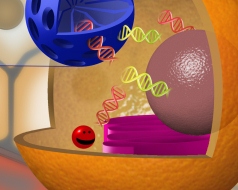06 March 2015
 The stuff of science fiction is moving closer and closer to reality. Imagine nanoscale capsules loaded with therapeutic payloads that pass through the blood supply releasing their cancer-limiting agents, only when they meet the tumorous cancer cells.
The stuff of science fiction is moving closer and closer to reality. Imagine nanoscale capsules loaded with therapeutic payloads that pass through the blood supply releasing their cancer-limiting agents, only when they meet the tumorous cancer cells.
It may sound a bit like futuristic action thriller but research into this treatment is happening right now in South Australia.
The research from the University of South Australia and co-workers in Taiwan, published in Nature Communications this month and successfully demonstrated in mouse models, represents a new hope for a more effective treatment for lung cancer.
Research leader, Dr Ivan Kempson says the nanoscale capsules have already been developed and demonstrated successfully and have been loaded with two different genes.
“One of the genes helps to reinstate a mechanism in the cancer cells that enables them to self-destruct,” Dr Kempson says.
“The second one makes the cells produce their own photo-sensitive chemicals so that when exposed to laser therapy, they produce radicals that prompt the cancer cells to self-destruct.”
Dr Kempson says the therapy is being developed to target lung cancer which is responsible for about a quarter of all cancer-related deaths.
“Lung cancer has been a very difficult disease to treat because of the sensitivity of the lung tissue and the importance of lung function,” he says.
“Traditional treatments such as surgery, radiation therapy and chemotherapy have huge limitations.
“A relatively new therapy being used in the US for the treatment of lung cancer is photodynamic therapy (PDT) which relies on injecting the patient with a photosensitising chemical and then irradiation of the tumor with lasers.
“The chemical is selected to react with the laser light and produce reactive cells including radicals that can destroy the cancer cells.
“Our research could advance and refine that treatment by being able to deliver the photosensitising agents in a highly targeted way only to the cancer cells.”
Working with mice with aggressive lung cancer tumors the researchers have already extended life expectancy from 28 to 68 days.
“I think we are making some important steps along the road to finding a better treatment for lung cancer, but the research into the development of sophisticated nanocapsules will have wider applications for gene therapies and play its part in emerging photodynamic therapies.
“Our next step is to secure funding to acquire more pre-clinical data to develop and test the technology and work towards trials in humans.”
More information about the research is available here
The illustration is a representation of the nanocapsule working inside a cancer cell as it releases genes to help turn on cancers fighting properties. The photosensitive chemicals the cells have been turned on to generate is dubbed “KillerRed” by the researchers and is represented here by the red pac-man like character.
Media contact: Michèle Nardelli office: +61 8 8302 0966 mobile: 0418 823 673 email: michele.nardelli@unisa.edu.au



